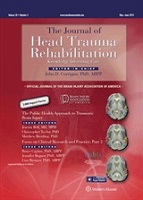Movement path tortuosity, compliance, TBI

Keywords:
Fractal D, traumatic brain injury (TBI), spatial disorientation, treatment compliance, veterans
Contact:
Abstract
Rehabilitation of patients with traumatic brain injury typically includes therapeutic prompts for keeping appointments and adhering to medication regimens. Level of cognitive impairment may significantly affect a traumatic brain injury victim's ability to benefit from text-based prompting. We tested the hypothesis that spatial disorientation as measured by movement path tortuosity during ambulation would be associated with poorer compliance with automated prompts by veterans actively being treated for traumatic brain injury.
Fractal Dimension, a measure of movement path tortuosity derived from a GPS logging device used to record casual outdoor ambulation at the start of the study. Compliance with smart home machine-generated therapeutic prompts received during rehabilitation at the James A. Haley Veterans Administration Hospital Polytrauma Transitional Rehabilitation Program. A patient was compliant with a prompt if they transited from where the prompt was presented to the prescribed destination (both within the Polytrauma Transitional Rehabilitation Program) within 30 minutes. Noncompliance was failure to appear at the destination within the allotted time.
The findings support the hypothesis that increased spatial disorientation adversely impacts compliance with automated prompts throughout therapy. The results are consistent with previous studies linking elevated path tortuosity to cognitive impairment and increased risk for falls in assisted living facility residents.
Citation
Kearns, W. D., Fozard, J. L., Ray, R. D., Scott, S., Jasiewicz, J. M., Craighead, J. D., & Pagano, C. V. (2015). Movement path tortuosity predicts compliance with therapeutic behavioral prompts in patients with traumatic brain injury. Journal of Head Trauma Rehabilitation, Advance online publication. doi:10.1097/htr.0000000000000126